YOU SHOULD SUBSCRIBE TO CLIMATE CHANGE WEEKLY.
IN THIS ISSUE:
- Climate Change and Texas’ Electric Power Problems
- Podcast of the Week: The Miseducation of Science Teachers
- Green Energy Is Toxic
- Tornado Damage, Losses Have Declined Amid Warming
- Video of the Week: Gavin Newsom Should Sue Himself Over Climate Change
- Climate Comedy
- Recommended Sites
Miss Anything at Heartland’s Climate Conference? No Problem.

Climate Change and Texas’ Electric Power Problems
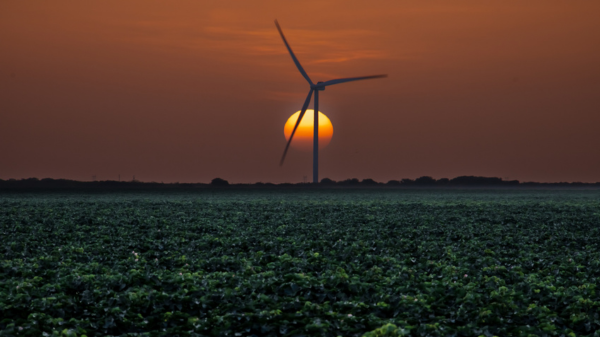
The manager of the vast majority of Texas’ power grid, the Electric Reliability Council of Texas (ERCOT), sent out multiple “voluntary conservation notice[s]” this summer. There were more than I can ever remember, and I’m a native Texan who has lived here 53 of my 60 years on Earth. Even on days when ERCOT didn’t send out an official notice requesting people to conserve, television and online news outlets almost daily admonished their audiences to conserve energy: turn thermostats up, turn lights and unused electronics off, and do not use appliances during peak periods. ERCOT was warning that Texas’ spare electric power capacity was thin and outages were possible.
Summers are hot in Texas, but some summers are hotter than others, and this was one of them. It was not the hottest in history or even recent years, but it was hot. Dallas County, where I live, experienced 55 days of temperatures above 100 degrees this summer, with more with a couple of days topping 108 degrees. The year 2023 ranks in fourth place for the number of 100 degree days in Dallas since consistent records have been kept. Some daily records were broken for Dallas and the state, but the overall state record of 120℉ set in the tiny town of Seymour in 1920 and tied in the only slightly larger town of Monahans in 1994 remains intact.
In 1980, 1998, and 2011, despite experiencing more 100 degree days than in 2023, Texas did not have the kind of systemwide threats to its electric power grid it had this year. Nor has Texas ever experienced the kind of winter power outage it had in 2021, when the power for more than four million people across the state was out for most of three full days and more than 700 people perished from the cold.
Climate policies—specifically restrictions or threats of restrictions on carbon dioxide from power plants, and mandates and subsidies for wind and solar power—are responsible for Texas’ power woes.
In a previous issue of Climate Change Weekly I detailed how the collapse of wind and solar power output during the winter storm, the prior closure of baseload coal plants, and poor power routing decisions by ERCOT combined to produce Texas’ deadly winter outage.
Data from ERCOT confirm that four days before the first snowflake fell, wind and solar were providing 58 percent of the electric power used in Texas. Fortuitously, the sun had been shining and the wind blowing. These conditions ended as the winter storm hit, and within a matter of hours more than 13,000 megawatts of wind and solar power went offline. The wind died off and the turbines began to freeze, and winter storm clouds blocked the sun.
That winter storm, although severe, was not unprecedented. The widespread power outage during winter was.
Summer has always been peak power demand season in Texas, and historically we had a good margin of peak power to meet residents’ and businesses’ needs. That margin has declined sharply over the past 17 years as wind and solar power have grown to account for a greater share of Texas’ electric power capacity. Those two sources of power now account for more than 39 percent of Texas’ electric power supply capacity— much more than coal, nuclear, and hydropower combined.
This increase was not driven by customer demand but by politics. Legislators required a set minimum amount of power sold on the Texas power market to come from wind or solar power, regardless of the costs and the reliability and redundancy problems it introduced into the grid. On top of that, federal, state, and local subsidies encouraged wind and solar to grow beyond the minimum amount set by the state. School districts have gotten in on the boondoggle, issuing property tax abatements to build wind and rooftop solar so they could teach their students the virtues of going green even as they cry poverty in Austin and with local property tax auditors, asking for ever-more money.
We saw the result this summer, with near-daily warnings of imminent power failures during the heat. As the Texas Tribune noted in mid-August amid the streak of 100 degree days,
Electricity users have exceeded the record for power demand on the state’s main grid 10 times so far this summer, according to ERCOT data. …
A significant increase in solar farms built in recent years in Texas has helped meet increasing demand. Texas can also produce the most wind power of any state. But solar power declines as the sun sets. And on Thursday, ERCOT cited low wind power generation as an additional cause for concern.
Although most of those days were thirsty bluebird sunny, the extreme heat even dampened the ability of solar power to keep Texans’ lights on and air conditioners cycling. The photovoltaic cells in solar panels tend to operate less efficiently when temperatures rise above 77℉. Ecoflow writes,
For every degree Celsius above 25°C (77°F), a solar panel’s efficiency typically declines by 0.3% to 0.5%.
This decrease in efficiency can be significant in regions where temperatures rise dramatically during the day, such as deserts or tropical areas.
When temperatures were above 100℉ for weeks on end for 55 days this summer and well above 90 for the remainder of the past four and a half months—which is true as I sit in my office and write today—solar panels were producing much less power than promised. How is more solar supposed to help out in the predicted warmer world?
ERCOT has a portal on its website where one can track, almost minute by minute, power demand and supply in Texas and what sources are meeting demand. I checked it periodically throughout this summer’s heat wave, as I’m checking it now, and the story it told was almost always the same. Relatively low wind and solar output compared to rated capacity, and near maximum production from nuclear, natural gas, and the state’s remaining coal power plants. As I write at 3:45 p.m. on Wednesday, September 27, with the temperature at 95℉, wind, the second-largest source of electric power in the state (accounting for more than 25 percent of the state’s electric power capacity), is producing only approximately one-quarter of its rated capacity. Overall, it is currently satisfying just 3.4 percent of the state’s power demand.
It turns out the wind doesn’t blow very well in the summer in West Texas where most of the turbines take up space.
Solar power, the third-largest generating source in Texas by stated capacity, is operating at just 57 percent of capacity on a clear, sunny day, meeting just 14.7 percent of the state’s demand. That is 2 percent less than coal, even though coal has only 65 percent of solar’s generating capacity. And of course, as common sense tells us and ERCOT’s monitor confirms, solar’s capacity will drop to zero or near-zero as night falls, regardless of the demand for power.
Relying on green energy to keep the lights on is a pipedream—in fact, it is an increasingly expensive nightmare. That’s true not just in Texas, where electricity prices have risen inexorably in recent years as each megawatt of wind and solar has been added to the system, but across the United States and in Europe as well. Independent system operators in the United States are increasingly warning that adding more intermittent power to the grid and prematurely closing coal power is a recipe for more outages and blackouts, which have already begun trending upward with the renewable energy mandates and subsidies.
Despite all of this effort, carbon dioxide emissions are trending ever-upward because of growth in China and other developing countries, which are using coal to power their economic progress. If one believes (as I do not) that carbon dioxide is driving dangerous climate change, there is no climate benefit from these expensive U.S. mandates and subsidies for wind and solar power.
Never fear, however: there is a silver lining to this dark cloud. Politically connected green energy elites and politicians beholden to them are profiting handsomely from this boondoggle. It’s only us peons who will swelter or shiver in the dark when President Joe Biden’s net-zero goals come to fruition.
Sources: ERCOT; Texas Tribune; Climate Change Weekly; Climate Change Weekly
Get your Copy at Amazon TODAY!
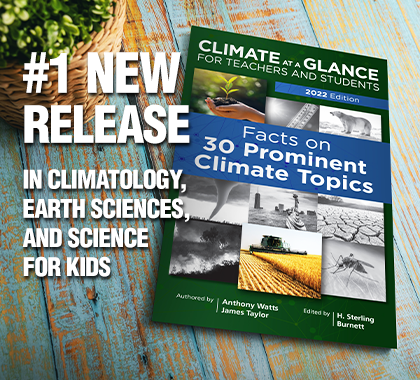
Podcast of the Week
Recently a prominent science educator, Stanford’s Jonathan Osborne, opined that the goal of science is consensus. Science is a process whose purpose is the pursuit of knowledge, a process which often overturns consensus. Osborne’s statements dismiss the scientific method, and critical thinking as a whole. This view of science would leave us in towards a dark age, with progress suddenly slowing to a halt. Osborne’s view seems to be that knowledge is socially constructed, not based on evidence and measurements, with scientific discovery being reduced to the counting of hands.
Subscribe to the Environment & Climate News podcast on Apple Podcasts, iHeart, Spotify or wherever you get your podcasts. And be sure to leave a positive review!
Green Energy Is Toxic
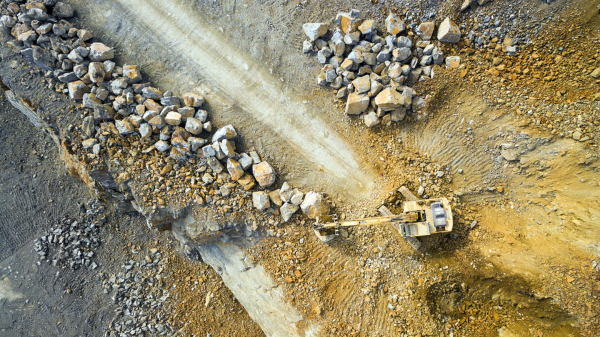
New research published in the journal Science shows the mining of metals to meet the demand for green energy technologies is polluting rivers and land and is probably harming people’s health.
Using empirically based modelling for lead, zinc, copper, and arsenic, combined with a global database of all known metal mining sites and intact and failed tailings storage facilities, the scientists concluded,
Worldwide, metal mines affect 479,200 kilometers of river channels and 164,000 square kilometers of floodplains. The number of people exposed to contamination sourced from long-term discharge of mining waste into rivers is almost 50 times greater than the number directly affected by tailings dam failures. [As a result] an estimated 23 million people live on floodplains affected by potentially dangerous concentrations of toxic waste derived from past and present metal mining activity.
In addition to the rivers, floodplains, and people affected by the pollution, the research suggests pollution from metal mining currently affects 5.72 million livestock animals and more than 16 million acres of irrigated farmland, The Daily Mail notes in its discussion of the study.
Of course, this research does not even address the pollution and health effects of lithium, cobalt, and myriad rare earth elements critical to so-called green batteries, solar panels, and wind turbines. As the production of green energy continues to grow, so will the demand for the mining of these metals and critical elements.
“According to the MIT Environmental Solutions Initiative, green energy technologies like wind turbines and electric cars often do require many more mined minerals than the present fossil fuels infrastructure,” The Daily Mail reports. “One electric car, for example, requires six times more metallic and mineral materials than a combustion engine car, MIT’s university team reports.
“And a wind power plant requires nine times more of these mined compounds than a traditional gas-fired plant,” The Daily Mail reports.
As a result, more green energy equals more mining and a need for radically improved waste disposal to avoid “business as usual” pollution.
To date, the researchers have mapped 159,735 abandoned mines and 22,609 active mines, plus 11,587 mining waste storage facilities and 257 known cases of failed and leaking storage sites.
Mark Macklin, lead author of the study and director of Lincoln University’s Lincoln Centre for Water and Planetary Health, says the research was intended to detail current locations where metal mining could already be producing dangerous impacts while developing mitigation measures.
“We expect that this will make it easier to mitigate the environmental effects of historical and present mining,’” Macklin told The Daily Mail. “Our new method for predicting the dispersal of mine waste in river systems provides governments, environmental regulators, the mining industry and local communities with a tool that, for the first time, will enable them to assess the offsite and downstream impacts of mining on ecosystem and human health.”
Sources: The Daily Mail; Science (behind paywall)
Heartland’s Must-read Climate Sites
Tornado Damage, Losses Have Declined Amid Warming
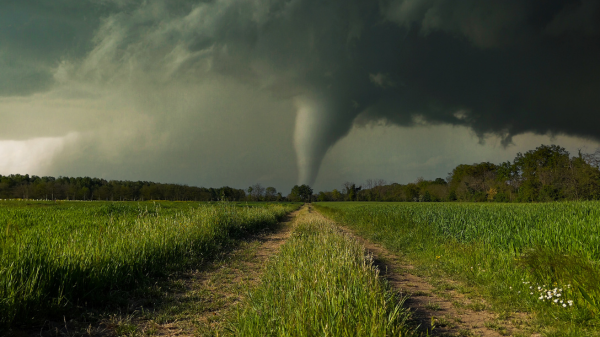
New research published in the journal Weather and Climate Extremes examined tornado data in the United States from 1954 through 2018 to determine whether any trends in strength and damage have appeared during the recent period of modest warming.
The team of Australian researchers (Zhang et al.) normalized the data on losses from tornadoes, using a dataset maintained by the U.S. National Weather Service’s Storm Prediction Center for the 65 years from 1954 through 2018. They also incorporated more detailed data on losses from individual tornado events collected since 1997. When the two datasets were combined and normalized, the researchers found, (a) for most U.S. states and in general there has been a decline in severe hurricanes, and (b) “[a]t the country level, both the severity of damage from individual events and the total annual losses from tornadoes are seen to have reduced over time … [resulting in a] national significant decline in normalized losses for tornado events.” See the graph below.
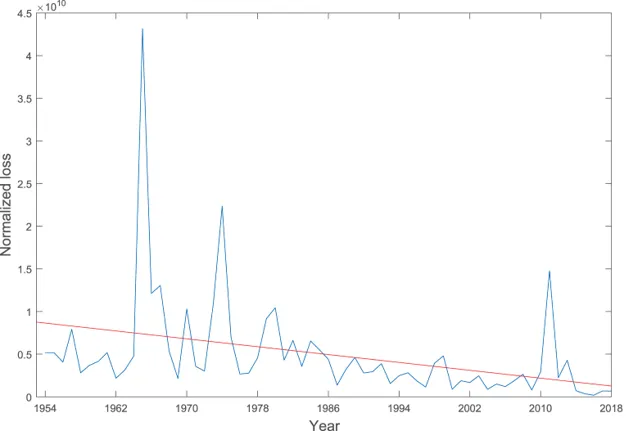
Although these findings have been largely ignored by the mainstream media, Roger Pielke Jr., Ph.D., was quick to discuss the importance of the paper’s findings.
Pielke, who has previously published peer-reviewed research on tornado damage and losses, was part of a team of researchers that provided the first comprehensive normalization of tornado losses. Their research, published in the journal Environmental Hazards in 2012, examined tornado impacts and losses in the United States from 1950 through 2011 and concluded “normalized tornado damage in the US from 1950 to 2011 declined in all three normalization methods applied (two are statistically significant[;] one is not).”
The authors of the new Weather and Climate Extremes paper explicitly acknowledge their new results confirm and extend the conclusions of the Environmental Hazards paper: “our findings reiterate the results of Simmons et al. (2013) who emphasize the importance of normalizing loss data to draw adequate conclusions about the severity of natural hazards.”
Pielke updated the data from his earlier coauthored paper with data from 2011 onwards and found tornado losses have continued to decline, as did Zhang et al.
Importantly, in addition to damage from tornadoes having declined over the past 70-plus years, Zhang et al. report incidences of the strongest tornadoes (F2 through F5) have likewise trended downward during that time. Also, Pielke notes that in nine of the 11 years since his paper was published in 2012, the United States has experienced below-average numbers of tornadoes.
Sources: Weather and Climate Extremes; The Honest Broker
Video of the Week
Heartland Institute President James Taylor was a guest on The Balance with Eric Bolling on Newsmax TV to talk about the absurdity of California Gov. Gavin Newsom to sue “Big Oil” for supposed damages the industry causes via all the carbon dioxide emissions we are all responsible for by living in a modern society. He was on the program with Heartland friend Daniel Turner, the founder of Power the Future.






























